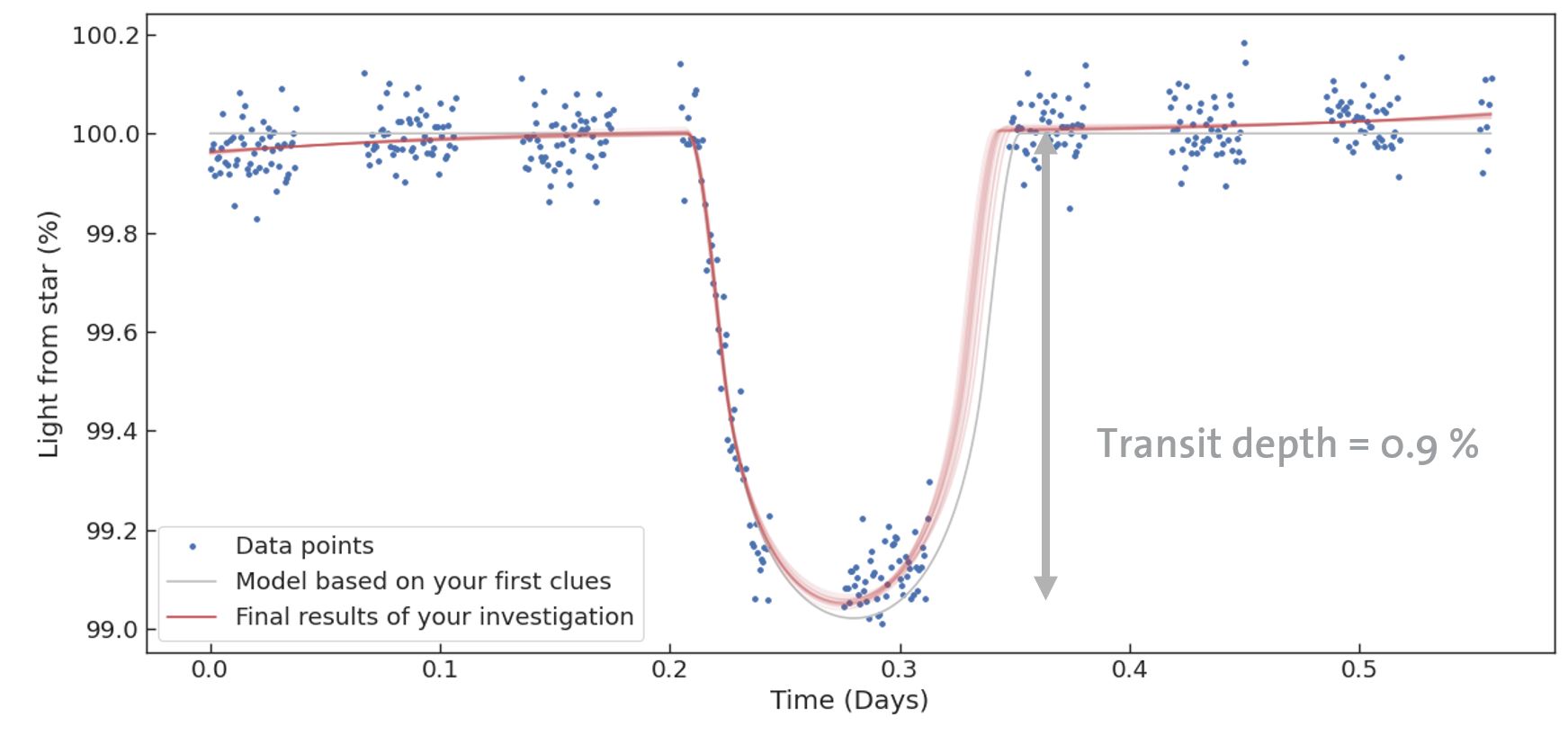
Step 2 – The Size of the Exoplanet
The depth of the exoplanet transit is equivalent to the ratio of the area of the planet’s disc and the area of the star’s disc. By measuring the transit’s depth from the transit light curve and knowing the stellar radius (Rs) you can determine the exoplanet’s radius (Rp). You can calculate the transit depth as a percentage with the equation below.
Transit depth (%) ≈ [katex]\frac{\pi\cdot{R_p}^2}{\pi\cdot{R_s}^2}\cdot \small{100}[/katex]

Watch the video on exoplanet size
Watch the video to learn more about exoplanet transit depth. Afterwards, complete your calculations with the equation and add the answer to the casefile.
Subtitles are available (automatically generated by YouTube) – select your language using the YouTube player controls.
Ready to check the solution?
Have you measured the size of the exoplanet? Check below to see whether your results match our expert’s solution for determining the size of KELT-3b. Do you need more help? Click to view the hint.
Let’s analyse KELT-3b data as an example. By analysing the Cheops data we can measure the transit depth (Figure 1).
Figure 1: KELT-3b data from Cheops with the transit light curve best fit model from allesfitter.
The radius of the star is known and provided in the case file, expressed in this example as a Sun radii:
[katex]R_s = a\cdot R_\text{Sun}[/katex]
We can rewrite the transit depth equation to determine the exoplanet radius expressed in Sun radii by inserting the expression above:
[katex]R_p = \sqrt{ \frac{\text{transit depth}}{100} \cdot {R_s}^2} = \sqrt{\frac{\text{transit depth}}{100}}\cdot R_s [/katex]
In the last step you can convert the exoplanet radius expressed in Sun radii to Earth radii. Search online the ratio b of the Sun to Earth radius and insert the expression:
[katex] R_{Sun}= b \cdot R_{Earth}
[/katex]
Let’s analyse KELT-3b data as an example. By analysing the Cheops data we can measure the transit depth to be approximately [katex]0.9\%[/katex] (Figure 1).
Figure 1: KELT-3b data from Cheops with the transit light curve best fit model from allesfitter.
The radius of the star of KELT-3b is known and provided in the case file, expressed in Sun radii:
[katex]R_s = 1.70 R_\text{Sun}[/katex]
We can rewrite the transit depth equation to determine the exoplanet radius expressed in Sun radii by inserting the expression above:
[katex]R_p = \sqrt{ \frac{\text{transit depth}}{100}}\cdot R_s = \sqrt{ \frac{0.9}{100}}\cdot 1.70 R_{Sun} = 0.161 R_\text{Sun}[/katex]
In the last step you convert the exoplanet radius expressed in Sun radii to Earth radii. The ratio of the Sun to Earth radius is 109 [source].
[katex]R_{Sun}=109R_{Earth}[/katex]
Inserting this expression results in:
[katex]R_p = 0.161 \text{x} 109 = 17.5 R_\text{Earth}[/katex]
How does your estimate of the size of the exoplanet compare to the best model fit value?
Step 2 Completed!
Your Investigation Progress
40%
Have you analysed the Cheops data and determined the size of your exoplanet? If yes, you can continue your investigation into the exoplanet’s properties with Step 3 – the orbital period and distance of an exoplanet!

Continue with Step 3 – Orbital Period and Distance







